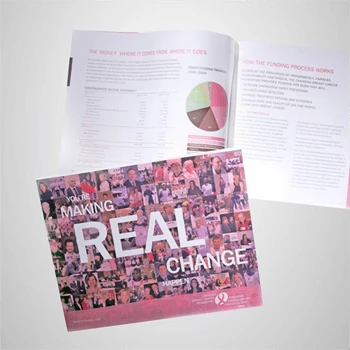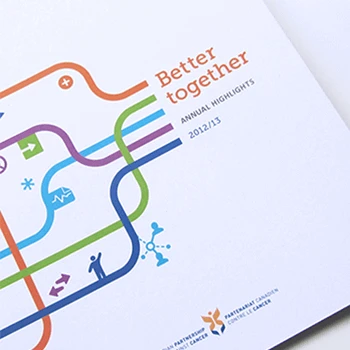What makes ESG sustainability report design different from other communications?
ESG reporting requires a unique balance of rigorous compliance, compelling storytelling, and impactful data presentation. These reports serve multiple stakeholders with different needs - investors seeking financial materiality, customers wanting authentic commitment, and regulators requiring specific disclosures. The design must make complex sustainability data accessible while maintaining credibility and meeting various reporting framework requirements.
Tip: Map your stakeholder priorities early to understand which data points and narratives matter most to each audience.
How do you ensure our ESG report meets multiple reporting framework requirements?
We design reports that accommodate various frameworks like GRI, SASB, TCFD, and emerging standards by creating modular content architectures. Using Experience Thinking content strategy principles, we develop information hierarchies that allow data to be presented in multiple formats and cross-referenced across frameworks. This approach reduces duplication while ensuring compliance with each standard's specific requirements.
Tip: Choose one primary framework as your foundation, then map how other required frameworks align or diverge from this structure.
What role does stakeholder mapping play in ESG report design?
Stakeholder mapping drives every design decision in ESG reporting. Different audiences - investors, customers, employees, regulators, communities - have distinct information needs and consumption preferences. We analyze how each stakeholder group interacts with sustainability information to create targeted content experiences while maintaining overall report coherence and brand consistency.
Tip: Survey your key stakeholders about their current ESG information needs and preferred communication formats before beginning design work.
How does materiality assessment influence report design and content structure?
Materiality assessment determines the content hierarchy and emphasis throughout your report design. High-materiality issues receive prominent placement, detailed explanation, and enhanced visual treatment. Following our Experience Thinking approach, we ensure report structure reflects actual business impact and stakeholder priorities, not just regulatory checklists. This creates more engaging, credible reports that resonate with readers.
Tip: Use your materiality matrix as a content prioritization tool, allocating space and visual emphasis proportionally to issue importance.
What's the relationship between ESG reporting and overall brand experience?
ESG reports are critical brand touchpoints that must align with your broader brand experience and values. Using our Experience Thinking framework, we ensure sustainability communications authentically express your organization's personality while meeting stakeholder expectations for transparency and accountability. The report becomes part of your connected experience ecosystem, reinforcing trust and credibility across all touchpoints.
Tip: Audit your existing brand materials to identify sustainability messaging gaps or inconsistencies before designing your ESG report.
How do you balance transparency with competitive sensitivity in ESG design?
Effective ESG design presents required transparency while protecting competitive advantages through strategic information architecture and visual emphasis. We help identify which sustainability efforts differentiate your organization and deserve prominent treatment versus standard industry practices that require basic disclosure. Content governance frameworks ensure consistent decision-making about what to highlight, explain, or simply report.
Tip: Establish clear criteria for what constitutes proprietary versus standard sustainability information before content development begins.
Why is accessibility crucial for ESG sustainability reports?
Accessibility in ESG reporting demonstrates authentic commitment to inclusion and ensures compliance with accessibility regulations. Digital-first report design must accommodate users with disabilities while serving diverse global audiences. This includes screen reader compatibility, alternative text for data visualizations, color contrast compliance, and plain language explanations of complex concepts. Accessibility failures can undermine sustainability credibility.
Tip: Build accessibility requirements into your initial project scope rather than retrofitting them after design completion.
What's your strategic approach to ESG report design projects?
Our approach follows Experience Thinking methodology, beginning with content strategy and stakeholder analysis before visual design. We audit existing sustainability data, analyze competitor approaches, and develop content architecture that serves both compliance and communication goals. Strategic foundation ensures design decisions support business objectives while meeting regulatory requirements and stakeholder expectations.
Tip: Gather all existing sustainability data and previous reports before starting design to understand content gaps and improvement opportunities.
How do you handle the complexity of sustainability data in design?
Complex sustainability data requires strategic information design that makes numbers meaningful and actionable. We create visual hierarchies that guide readers from high-level performance summaries to detailed metrics, using progressive disclosure to accommodate different stakeholder needs. Data visualization follows best practices for accuracy, clarity, and emotional connection without compromising scientific rigor.
Tip: Test data visualizations with actual stakeholders to ensure they understand key messages and can find specific information they need.
What content governance framework do you establish for ESG reporting?
Following Experience Thinking content governance principles, we establish multi-stakeholder review processes that ensure accuracy, compliance, and strategic alignment. This includes data verification workflows, legal review protocols, stakeholder approval processes, and version control systems. Governance frameworks prevent errors while maintaining project timelines and ensuring consistent quality across annual reporting cycles.
Tip: Map your internal approval processes early and build buffer time for the multiple review cycles that ESG reports typically require.
How do you ensure our report stands out while maintaining credibility?
Differentiation in ESG reporting comes from authentic storytelling and strategic visual design, not gimmicks. We identify your unique sustainability story and create compelling narratives around genuine achievements and transparent challenges. Visual design balances creative expression with the conservative expectations of financial and regulatory audiences, ensuring credibility while making your report memorable and engaging.
Tip: Benchmark competitor reports not to copy their approach, but to identify opportunities for authentic differentiation in your sustainability story.
What timeline should we expect for ESG report design projects?
ESG report projects typically require 12-16 weeks from strategy through final delivery, depending on data complexity and stakeholder requirements. This includes content strategy, data analysis, design development, multiple review cycles, and production preparation. The multi-stakeholder review process often creates longer timelines than other communication projects, requiring careful project management and clear milestone planning.
Tip: Start your ESG report design process earlier than you think necessary - data collection and stakeholder reviews always take longer than expected.
How do you accommodate both digital and print distribution needs?
Modern ESG reporting requires digital-first design that adapts effectively to print when needed. We create responsive design systems that optimize for screen reading while ensuring professional print presentation. Digital versions include interactive elements, enhanced data visualization, and accessibility features, while print versions maintain visual impact and data clarity. Both formats serve the complete stakeholder ecosystem.
Tip: Prioritize digital experience design since most stakeholders will encounter your report online, but ensure print versions don't lose critical functionality.
What role does AI play in ESG report content development and design?
AI tools enhance ESG reporting through data analysis, content optimization, and design efficiency without replacing human judgment on strategy and compliance. We use AI for pattern recognition in sustainability data, content gap analysis, and initial design exploration. However, ESG reporting requires human oversight for accuracy, regulatory compliance, stakeholder sensitivity, and authentic storytelling that reflects your organization's unique sustainability journey.
Tip: Use AI for data processing and initial content drafts, but always verify accuracy and ensure final content reflects authentic organizational voice and values.
How do you make complex sustainability metrics accessible to diverse audiences?
Accessibility in sustainability data requires layered information design that serves both expert and general audiences. We create executive summaries with key performance indicators, detailed metrics sections for analysts, and context explanations for non-experts. Visual design uses progressive disclosure, clear labeling, and contextual information to make complex data meaningful without oversimplifying important nuances.
Tip: Create data stories that connect metrics to real-world impact, helping stakeholders understand why specific numbers matter for your business and society.
What's your approach to data visualization in ESG reports?
Data visualization in ESG reporting must balance accuracy, clarity, and emotional connection. We use charts, infographics, and interactive elements that make trends and comparisons immediately apparent while maintaining scientific precision. Visual design considers color accessibility, cultural sensitivity, and the serious nature of sustainability topics. Every visualization supports specific communication goals rather than just displaying data.
Tip: Choose visualization types based on the story you want to tell with the data, not just the data type - trends, comparisons, and distributions each require different approaches.
How do you handle data quality and verification in report design?
Data quality is fundamental to ESG credibility. We establish verification workflows that include source documentation, calculation methodology, third-party validation, and clear uncertainty communication. Design elements include data source attribution, methodology notes, and confidence indicators where appropriate. Following content governance principles, we create review processes that prevent errors while maintaining design integrity and reader trust.
Tip: Document your data collection and calculation methodologies clearly - transparency about data limitations actually enhances rather than undermines credibility.
What approaches work best for presenting both achievements and challenges?
Authentic ESG communication requires balanced presentation of progress and ongoing challenges. We design information architectures that highlight achievements while transparently addressing areas for improvement. This includes clear goal-setting, honest progress assessment, and forward-looking improvement plans. Visual design uses consistent treatment for both positive and challenging information, maintaining credibility through honest, balanced storytelling.
Tip: Frame challenges as learning opportunities and improvement commitments rather than failures - this demonstrates authentic commitment to continuous sustainability progress.
How do you ensure data comparability across multiple reporting periods?
Comparative data requires consistent presentation methodologies and clear explanation of any changes in measurement approaches. We design template systems that maintain visual consistency across reporting cycles while accommodating evolving metrics and standards. Content architecture includes baseline establishment, trend analysis, and contextual explanations for methodology changes that ensure meaningful year-over-year comparisons.
Tip: Establish baseline years and maintain consistent measurement methodologies where possible - changes in approach should be clearly explained and justified.
What's the best way to present forward-looking goals and commitments?
Future commitments require clear target communication, timeline specification, and progress tracking mechanisms. We design goal presentation that includes specific metrics, achievement dates, interim milestones, and accountability measures. Visual design distinguishes between historical performance, current status, and future commitments while maintaining overall narrative flow and stakeholder confidence in your organization's ability to deliver.
Tip: Connect future goals to past performance trends to demonstrate realistic planning and build stakeholder confidence in your ability to achieve commitments.
How do you handle industry benchmarking and peer comparison data?
Industry comparisons provide context for performance assessment while respecting competitive sensitivity. We design comparison frameworks that highlight your organization's position without disclosing proprietary information or making unfair comparisons. This includes industry average references, percentile positioning, and peer group analysis that helps stakeholders understand relative performance within appropriate context.
Tip: Use industry associations and standardized benchmarks rather than specific competitor data to provide context while maintaining professional relationships.
How do you ensure our report meets evolving regulatory requirements?
Regulatory compliance requires ongoing monitoring of ESG disclosure requirements and flexible design systems that accommodate new mandates. We create modular content architectures that can be updated as regulations evolve, maintaining core design integrity while adding required elements. Our approach includes compliance tracking, requirement mapping, and version control systems that ensure current and future regulatory alignment.
Tip: Subscribe to regulatory update services and build quarterly review processes to stay current with changing ESG disclosure requirements in your jurisdictions.
What's your approach to integrating multiple ESG frameworks in one report?
Multi-framework integration requires strategic content architecture that eliminates duplication while ensuring complete coverage. Using Experience Thinking content strategy, we map overlapping requirements, identify unique elements, and create cross-reference systems that help readers navigate between frameworks. Design maintains visual consistency while clearly distinguishing framework-specific information and universal sustainability metrics.
Tip: Create a framework mapping matrix before content development to identify overlaps and unique requirements, streamlining both content creation and reader navigation.
How do you handle technical disclosure requirements without compromising readability?
Technical disclosures require strategic information design that meets compliance needs while preserving overall report accessibility. We use progressive disclosure techniques, appendix organization, and clear cross-referencing that allows technical detail without overwhelming general readers. Content governance ensures required information is complete and accurate while maintaining engaging narrative flow for broader audiences.
Tip: Group technical disclosures in dedicated sections with clear navigation, allowing readers to access detail when needed without disrupting the main sustainability story.
What quality assurance processes ensure accuracy in ESG reporting?
ESG accuracy requires multi-layer review processes that include data verification, calculation checking, source documentation, and legal compliance review. We establish review workflows that involve sustainability experts, finance teams, legal counsel, and external auditors where appropriate. Quality assurance includes version control, change tracking, and approval documentation that maintains audit trails throughout the development process.
Tip: Establish clear roles and responsibilities for different types of review - data accuracy, regulatory compliance, brand alignment - to prevent gaps or conflicts in the approval process.
How do you accommodate third-party verification and assurance requirements?
Third-party verification requires design that facilitates auditor review while maintaining reader engagement. We create clear data source documentation, calculation methodology explanations, and audit trail preservation that supports verification processes. Content architecture includes verification status indicators, assurance statements, and clear distinction between verified and unverified information that builds stakeholder confidence.
Tip: Involve your external auditors early in the design process to understand their documentation requirements and avoid costly revisions later.
What approach do you take to emerging ESG disclosure requirements?
Emerging requirements require adaptive design systems that can accommodate new disclosure mandates without complete redesign. We monitor regulatory developments and create flexible content frameworks that anticipate likely future requirements. This includes modular design systems, expandable data sections, and governance processes that can quickly integrate new requirements while maintaining overall report integrity and stakeholder experience.
Tip: Build flexibility into your reporting template now - requirements will continue evolving, and adaptable systems reduce future redesign costs and timeline pressure.
How do you ensure global compliance across different regulatory jurisdictions?
Global compliance requires understanding diverse regulatory environments and creating design systems that accommodate multiple requirements. We map jurisdiction-specific mandates, identify common elements, and create content architectures that serve global distribution while meeting local requirements. This includes language considerations, cultural sensitivity, and region-specific data presentation that maintains brand consistency across markets.
Tip: Prioritize the most stringent regulatory requirements as your baseline - meeting higher standards typically ensures compliance across multiple jurisdictions.
How do you design for different stakeholder information needs within one report?
Multi-stakeholder design requires strategic information architecture that allows different audiences to find relevant information efficiently. Following Experience Thinking principles, we create layered content structures with executive summaries, detailed metrics, contextual explanations, and technical appendices. Navigation design helps each stakeholder group access their priority information while understanding the broader sustainability context.
Tip: Create stakeholder-specific entry points or reading guides that direct different audiences to their most relevant content sections.
What's your approach to making ESG reports engaging for non-expert audiences?
Non-expert engagement requires storytelling techniques that make sustainability meaningful and accessible without oversimplifying complex issues. We use narrative structures, real-world impact examples, employee stories, and visual metaphors that connect abstract metrics to tangible outcomes. Design balances professional credibility with human interest, making sustainability personal and relevant to diverse reader backgrounds.
Tip: Include real employee stories and community impact examples to make sustainability metrics meaningful and memorable for general audiences.
How do you balance investor-focused financial materiality with broader stakeholder interests?
Balanced stakeholder communication requires content strategy that addresses financial materiality while acknowledging broader sustainability impacts. We create information hierarchies that present business-critical metrics prominently while providing complete sustainability context. This approach satisfies investor requirements for material information while demonstrating authentic commitment to comprehensive sustainability to other stakeholders.
Tip: Use your materiality assessment to guide content emphasis, but don't ignore lower-materiality issues that matter to non-investor stakeholders.
What digital distribution strategies enhance ESG report accessibility?
Digital distribution requires multi-channel strategy that meets stakeholders where they consume information. We design responsive web experiences, downloadable formats, interactive dashboards, and social media adaptations that extend report reach and engagement. Digital-first design includes accessibility features, search optimization, and analytics tracking that measure stakeholder engagement and inform future communication strategies.
Tip: Create multiple content formats from your core report - infographics, video summaries, and data dashboards can extend reach and engagement beyond the traditional PDF format.
How do you address skepticism and build credibility with critical audiences?
Credibility building requires transparent communication, third-party validation, and honest acknowledgment of challenges alongside achievements. We design content that addresses common skepticism points directly, provides verifiable data sources, and demonstrates authentic commitment through concrete actions and measurable progress. Visual design maintains professional tone while showing genuine engagement with sustainability challenges.
Tip: Acknowledge your organization's past sustainability challenges and clearly explain current improvement efforts - transparency builds more credibility than perfection claims.
What role does employee engagement play in ESG report authenticity?
Employee voices provide authentic perspective that enhances report credibility and demonstrates organizational commitment. We integrate employee stories, quotes, and insights that show sustainability integration in daily operations. Content strategy includes worker perspectives on sustainability initiatives, safety programs, diversity efforts, and community engagement that make abstract policies tangible and credible to external stakeholders.
Tip: Include employees from different levels and departments to show sustainability commitment throughout your organization, not just from leadership.
How do you measure stakeholder engagement and report effectiveness?
Report effectiveness requires metrics that track both engagement and behavior change. We establish measurement frameworks that include download rates, reading time, stakeholder feedback, media coverage, and subsequent sustainability discussions. Following Experience Thinking principles, we also track how report content influences stakeholder relationships, investment decisions, and partnership opportunities over time.
Tip: Survey key stakeholders after report publication to understand which content was most valuable and what information gaps remain for future reporting cycles.
What deliverables do you provide for ongoing ESG reporting cycles?
Ongoing reporting support includes template systems, content governance frameworks, and design guidelines that enable consistent annual reporting. We provide editable templates, data visualization standards, photography guidelines, and brand application rules that maintain design quality across future cycles. Implementation support includes training for internal teams and collaboration with external partners who may contribute to future reports.
Tip: Invest in template systems and style guides that can be reused across multiple reporting cycles - this reduces future design costs and ensures consistency.
How do you train our internal team to maintain report quality and consistency?
Training programs include design system education, content governance instruction, and quality control procedures that enable internal team success. We provide guidelines for data presentation, content approval workflows, visual consistency standards, and common problem troubleshooting. Training ensures your team can execute annual updates while maintaining professional quality and stakeholder trust.
Tip: Designate internal ESG communication champions who can maintain design standards and coordinate with external partners for specialized content or design support.
What support do you provide for translation and global distribution?
Global distribution support includes translation-ready design systems, cultural adaptation guidelines, and multi-language layout considerations. We create flexible templates that accommodate text expansion, right-to-left languages, and cultural design preferences while maintaining brand consistency. Support includes coordination with translation services and adaptation for different market expectations and regulatory requirements.
Tip: Plan for text expansion when designing layouts - translated content often requires 20-30% more space than English, affecting design balance and information hierarchy.
How do you ensure report accessibility across different platforms and devices?
Cross-platform accessibility requires responsive design systems that maintain functionality across desktop, tablet, and mobile devices. We test reports on various platforms, screen sizes, and assistive technologies to ensure universal access. Implementation includes file optimization, loading speed consideration, and alternative format provision that serves diverse technological capabilities and user preferences.
Tip: Test your report on older devices and slower internet connections - many global stakeholders may not have access to the latest technology.
What ongoing consultation do you provide for future reporting evolution?
Ongoing consultation includes regulatory update monitoring, design system evolution, and strategic communication guidance as your sustainability program matures. We provide annual review services, template updates for new requirements, and strategic advice for enhancing stakeholder engagement. Long-term partnerships ensure your ESG communication evolves with regulatory changes and organizational growth.
Tip: Schedule annual consultation reviews to assess report performance, stakeholder feedback, and regulatory changes that may affect future reporting requirements.
How do you help integrate ESG reporting with other corporate communications?
Integration strategy ensures ESG reporting aligns with annual reports, investor presentations, marketing materials, and other corporate communications. Using Experience Thinking framework, we create consistent messaging, visual alignment, and content coordination that reinforces sustainability commitments across all touchpoints. Integration prevents conflicting messages while amplifying sustainability impact throughout your communication ecosystem.
Tip: Create a central sustainability messaging repository that all communication teams can access to ensure consistent language and data across different materials.
What project management approach ensures successful ESG report delivery?
ESG project management requires specialized approaches that accommodate data collection timelines, multiple stakeholder reviews, and regulatory deadlines. We use project frameworks that include milestone planning, risk management, stakeholder coordination, and quality control processes specific to sustainability reporting. Clear communication protocols and contingency planning ensure on-time delivery despite complex approval processes.
Tip: Build buffer time into your project timeline for unexpected data delays or additional stakeholder review cycles - ESG reports often encounter more revision requests than other communications.
How does professional ESG report design impact stakeholder perception?
Professional design demonstrates organizational commitment to sustainability and attention to detail that stakeholders expect from credible ESG reporting. Quality design builds trust, enhances readability, and ensures key messages resonate with diverse audiences. Following Experience Thinking principles, design quality reflects broader organizational values and influences how stakeholders perceive your sustainability authenticity and long-term commitment.
Tip: Invest in professional design quality that matches your organization's brand standards - poor design quality can undermine even excellent sustainability performance.
What business outcomes can result from effective ESG communication design?
Effective ESG communication can influence investor confidence, customer loyalty, employee engagement, regulatory relationships, and partnership opportunities. Clear, credible sustainability reporting supports ESG ratings, facilitates access to sustainable financing, and attracts sustainability-focused talent and customers. Design quality amplifies these business benefits by ensuring stakeholders understand and trust your sustainability story.
Tip: Track business metrics that correlate with ESG communication quality - investor inquiries, partnership proposals, and employee retention can indicate communication effectiveness.
How do you ensure ESG reports support long-term sustainability strategy?
Strategic ESG communication requires alignment between reporting content and organizational sustainability strategy. We ensure report design supports goal communication, progress tracking, and accountability mechanisms that drive internal improvement while building external trust. Content architecture includes forward-looking elements that connect current performance to future commitments and strategic sustainability integration.
Tip: Use your ESG report as a strategic planning tool, not just external communication - clear goal articulation and progress tracking can enhance internal sustainability momentum.
What role does ESG reporting play in risk management communication?
ESG reporting provides platform for communicating climate risks, social risks, and governance risks that impact business operations and stakeholder value. Design presents risk assessment, mitigation strategies, and adaptation planning in accessible formats that build stakeholder confidence in organizational resilience. Risk communication balances transparency with strategic positioning that demonstrates proactive management capabilities.
Tip: Frame risk discussions as strategic opportunities for innovation and competitive advantage rather than just compliance requirements or unavoidable challenges.
How do you measure the long-term impact of ESG communication quality?
Long-term impact measurement includes stakeholder relationship tracking, reputation monitoring, business opportunity assessment, and sustainability performance correlation. We establish baseline metrics and monitoring systems that connect communication quality to stakeholder engagement, business results, and sustainability progress. Measurement frameworks help optimize future communication strategies and demonstrate ROI for sustainability communication investment.
Tip: Establish baseline stakeholder perception metrics before launching improved ESG communication to measure long-term relationship and business impact.
What competitive advantages can result from superior ESG report design?
Superior ESG communication can differentiate your organization in competitive markets, attract sustainability-focused stakeholders, and position your company as a sustainability leader. Quality design enhances message credibility, improves stakeholder engagement, and supports premium positioning in sustainable business practices. Following Experience Thinking, superior communication reflects and reinforces actual sustainability performance advantages.
Tip: Benchmark competitor ESG communications to identify opportunities for authentic differentiation, but ensure superiority claims are backed by actual performance improvements.
How does ESG reporting design support organizational culture and employee engagement?
Internal ESG communication builds employee pride, reinforces organizational values, and demonstrates leadership commitment to sustainability. Quality design makes sustainability achievements visible and meaningful to employees while providing tools for external stakeholder engagement. Employee involvement in report development and distribution enhances cultural integration and authentic sustainability commitment throughout the organization.
Tip: Share your ESG report internally before external publication to build employee pride and prepare staff to discuss sustainability commitments with external stakeholders.












